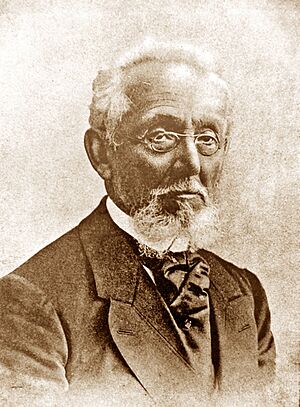Mendele Mocher Sforim facts for kids
Mendele Mocher Sforim (which means "Mendele the book peddler") was a very important Jewish author. His real name was Sholem Yankev Abramovich. He was one of the main people who started modern Yiddish and Hebrew literature. He lived from 1836 to 1917.
Contents
Early Life and Learning
Mendele was born in 1836 in a town called Kapyl, which was part of the Russian Empire. His family was poor and Jewish. His father died when Mendele was still young, shortly after his bar mitzvah.
He went to a yeshiva, which is a Jewish religious school, in Slutsk and Vilna. He studied there until he was 17 years old. During this time, he often struggled and was hungry.
After his studies, Mendele traveled a lot. He went through places like Belarus, Ukraine, and Lithuania. He traveled with a beggar named Avreml Khromoy. This person later inspired a character in one of Mendele's books, Fishke der Krumer. In 1854, Mendele settled in Kamianets-Podilskyi. There, he met a writer named Avrom Ber Gotlober. Gotlober helped Mendele learn about different cultures, philosophy, and other languages like Russian.
Starting His Writing Journey
Mendele's first article was called "Letter on Education." It appeared in 1857 in the first Hebrew newspaper, Hamagid. His teacher, Gotlober, sent Mendele's school paper to the newspaper without him knowing!
From 1858 to 1869, Mendele lived in Berdichev. Here, he started writing stories in both Hebrew and Yiddish. He wrote things that made fun of powerful local people, which caused some trouble. Because of this, he left Berdichev.
He then went to Zhitomir to train as a rabbi. He lived there from 1869 to 1881. After that, in 1881, he became the head of a traditional school in Odessa. He stayed in Odessa until he died in 1917. For two years, he lived in Geneva because he had to escape from attacks against Jewish people after the failed revolution of 1905.
The Grandfather of Yiddish Literature
Mendele first wrote in Hebrew. He even made up many new words in that language. But he later decided to write in Yiddish. He did this so more people could read his stories.
He used a pen name, "Mendele Mocher Sforim." At that time, many people thought Yiddish was just a simple language. They didn't think it was good enough for serious books. Mendele, like another famous writer named Sholem Aleichem, used a pen name to challenge this idea. He showed that Yiddish could be used for important literary works.
His writing was greatly influenced by the Haskalah, which was a movement for Jewish enlightenment. Many people call him the "grandfather of Yiddish literature." Sholem Aleichem first gave him this title. Mendele's writing style in both Hebrew and Yiddish had a big impact on many writers who came after him.
While Yiddish newspapers had been around for a while, Kol Mevasser was very important. Mendele supported this newspaper from the start. He published his first Yiddish story, Dos kleyne Mentshele (The Little Man), there in 1863. This newspaper is seen as the first strong and important Yiddish newspaper.
Mendele's Ideas and Later Books

In his early Yiddish stories, Mendele wanted to help his people. He wasn't just trying to become famous. Two of his early works, Dos kleyne mentshele (The Little Man) and the play Di Takse (The Tax, 1869), criticized corruption. They showed how religious taxes, like the tax on kosher meat, were used by community leaders instead of helping the poor.
He continued this satire (making fun of things to show problems) in Di Klatshe (The Nag, 1873). This story is about a prince, who represents the Jewish people. The prince is turned into a mistreated animal but stays morally good despite his suffering.
His later books became kinder and less focused on satire. This change started with Fishke der Krumer (Fishke the Lame), which he worked on from 1868 to 1888. This book was even made into a movie in 1939. Another important work was the unfinished book The Travels of Benjamin III (1878). This book is a bit like a Jewish version of Don Quixote, where the main character goes on funny adventures. The title refers to a famous medieval Jewish traveler named Benjamin of Tudela.
Mendele also spent many years writing his long novel Dos Vinshfingeril (The Wishing Ring, 1865–1889). This story is about a maskil, someone who supports the Haskalah movement, just like Mendele himself. The character escapes a poor town and gets an education. But then, attacks against Jewish people in the 1880s change his dreams of everyone living together. He starts to hope for Jewish nationalism instead. The first English translation of this book came out in 2003.
Important Works
- Limdu hetev (Learn to Do Good, 1862)
- Dos kleyne mentshele (The Little Man, 1864)
- Di Takse (The Tax, 1869)
- Di Klatshe (The Nag, 1873)
- Fishke der Krumer (Fishke the Lame, 1868-1888)
- Dos vintshfingerl (The Wishing Ring, 1865–1889)
- The Travels of Benjamin III (1878)
- Shloyme Reb Khayims (An Image of the Yiddish Life in Lithuania, 1899–1912) - This book was never finished.
Images for kids



